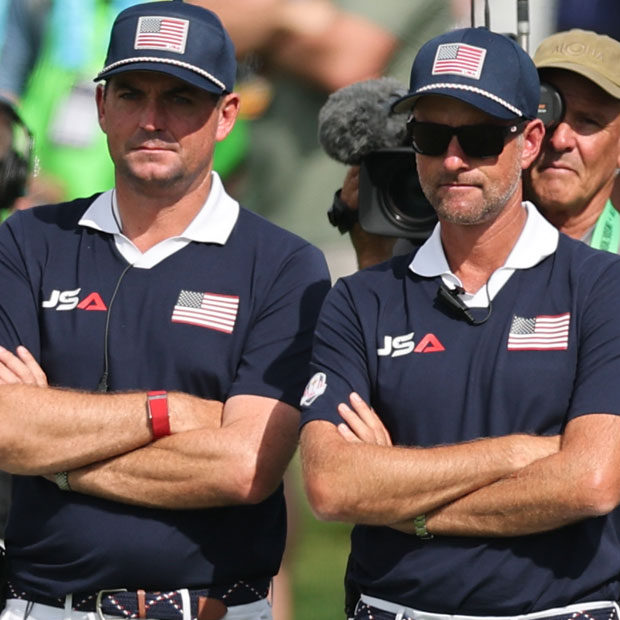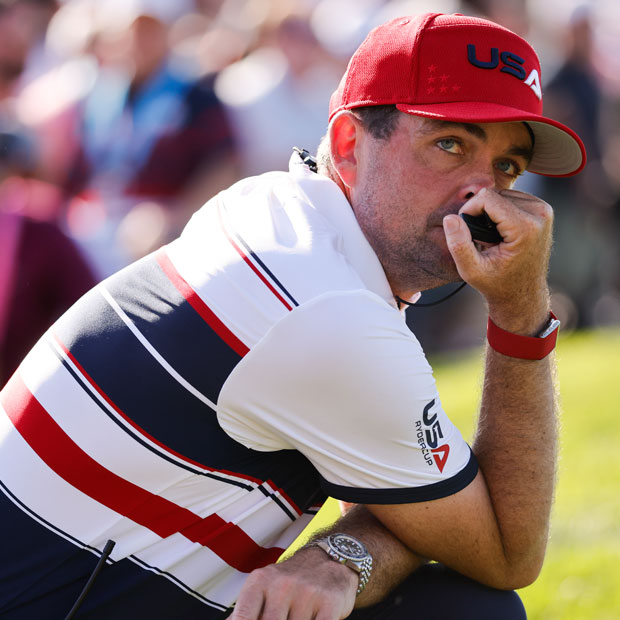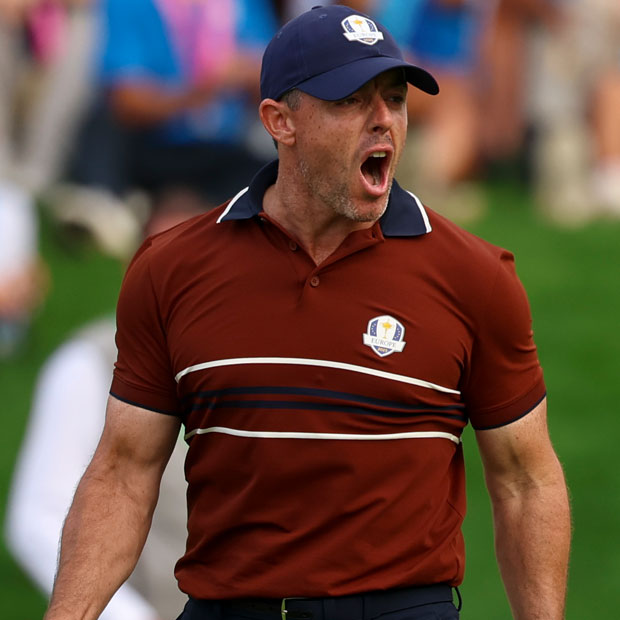2025 Masters First Round Recap, Leaderboard, and Notes
The first round of the Masters didn't disappoint


Rose Leads Once Again
By Joseph LaMagna
For the fifth time in his Masters career, Justin Rose is the leader in the clubhouse after 18 holes.
As much (deserved) talk as there will be of Rose’s track record at Augusta National, his record in all major championships shouldn’t be overlooked. Rose has 14 top 10s in majors since 2015, more than any other player but four, and he’s recorded at least one top 10 every year since 2015 (except 2022). At nearly 45 years old, Rose still brings it consistently on the biggest stages, as evidenced by a brilliant opening round 7-under 65 that earned him a three-shot lead.
Sitting right behind him, world No. 1 Scottie Scheffler delivered a quality first-round performance, firing a 4-under 68 on a day that averaged 73.59 scoring. Scheffler’s ball-striking didn’t rise to his elite standards, but two drained 40-plus footers on Nos. 4 and 16 helped Scottie find his way to a share of second place. Of all the players Rose shouldn’t want to see near the top of the leaderboard, Scheffler is 1a.
In other top player news, world No. 2 Rory McIlroy stood at 4 under through 14 holes, squarely in the hunt. Then, things went off the rails. Following a decent approach shot just over the back of the 15th green, McIlroy misplayed the ensuing chip and found the water hazard past the pin that guards the front of the green. He went on to make double bogey. Shortly thereafter, McIlroy recorded another double on the 17th after a few consecutive sloppy shots — a miscue that is much harder to excuse than the delicate chip from behind the 15th.
Elsewhere in results, 25-year-old Ludvig Aberg played excellently en route to an opening round 4-under 68 to share second place with Scheffler and Corey Conners. Reigning U.S. Open champion Bryson DeChambeau sits just one behind that trio after an opening round 3-under 69. In less inspiring performances, Jon Rahm struggled to an opening round 3-over 75, appearing visibly frustrated throughout the day.
So how far back is too far back?
As always, the answer depends. We’re still early in this tournament. However, historical Masters data suggest that it’s difficult to overcome a significant first-round deficit. This isn’t a high-variance golf course like TPC Sawgrass where leaderboards are turbulent. Forty-five of the 88 Masters winners have been within two of the lead after 18 holes. Fifteen winners have overcome a deficit of five strokes or more, and nobody has ever overcome a deficit of more than seven strokes. It can be done, but gaining multiple strokes per round on the top contenders is very difficult around here. If you’re one of the 10 golfers currently within five of Rose’s lead, you should feel decent about your chances. If you’re outside of the top 10, you’re going to need some good fortune, but stranger things have happened.
We’re set up for a wonderful three days of action. Light overnight rain is in the forecast, but it shouldn’t dampen the golf course too much. Whoever wins this tournament is going to have to beat a pack of the best players in the world, and they’ll have to pass arguably the best test in professional golf: a firm, fiery Augusta National.
Varying Approaches to Augusta National
By Andy Johnson

One of the great joys of the Masters is watching the artful way an aging past champion chooses to attack Augusta National. This year, Bernhard Langer is playing his 41st and final Masters. For those not following the Champions Tour, Langer is still a formidable player at 67 years old. The two-time Masters champion was paired with one of the youngest and longest players in field, Noah Kent, a sophomore at the University of Florida, who earned his invitation via a runner-up finish at the U.S. Amateur.
There is no other tournament in the world where you can see a promising 20-year-old in the same group as an aging legend. The juxtaposition in their respective games is fascinating. Langer, who hasn’t had power to lean on at Augusta National in decades, has taken on the challenging design through strategic decisions. Kent on the other hand, leaned into his immense distance advantage right off the bat, sending his drive over the fairway bunkers on No. 1 and leaving a mere flip wedge into the brute par 4. Langer was forced to play the hole quite differently, making it about halfway up the hill off the tee and hitting a fairway wood into the green.
It didn’t take long for Langer’s experience and moxie to reveal itself. On the par-5 second, with a tricky back-left hole location, Langer hit his layup as far right as possible to set up a perfect angle to approach the green. Kent played to the left to leave a challenging pitch over the bunker. On the third, Kent went for the green while Langer hit a fairway wood to the left edge of the fairway, again setting up a primo angle to approach the back-right pin. Both made birdie in drastically different ways.
At the eighth hole, where the big hitters were simply ripping it over the bunker, Langer hit 259-yard shot short of the bunker and, with a back left pin, advanced it another 230 yards with a runner up the right side of the hill to set up the great angle to the back-left pin. He had a fairly clear line of sight from 93 yards and the green to work with in between the famous mounds that surround it. His distance control left him and the wedge ran just long through the green, but the worst he was making was a two-putt par. It may be harder to go for an eagle like some of the bombers at a significant distance deficit, but Langer was working the right side of the hole to avoid any of the costly mistakes that would surely spell doom for the old timer.

Langer’s understanding of the golf course and Kent’s unique talent represented the two ingredients needed to win over 72 holes at Augusta National. Langer more than likely won’t win, but after a 2-over 74 in the first round, he has the chance to play the weekend because he knows exactly how to work his way around the golf course. One of the best features of Masters.com is the ability to watch every shot, and my favorite ritual after a day at Augusta National is diving in and watching exactly how guys like Langer and Jose Maria Olazabal strategically work their way around Augusta National without the tools to overpower its design.
Between the Ears
By Will Knights
Arguably the best thing you can say about Augusta National — a brawny golf course that takes an incredible physical toll on a player — is that everyone gets off the golf course and talks about how exhausted they are mentally, not physically. Any lapse in concentration at all, and you’re reeling. Try to push the issue, and the course pushes back even harder. Nick Taylor said it best in his post-round interview on Thursday: “If you hang in there mentally as long as you can, hopefully good things happen, but if you start pressing out here, that’s when things can start going a little [sideways].”
We saw this time and time again in the first round. Nick Dunlap was both a little loose and too aggressive and found a way to take a penalty shot on five different holes (Nos. 5, 11, 12, 13, and 16). Patrick Cantlay got the full brunt of the 15th green, chipping it into the water twice on his way to a triple bogey. Rory McIlroy followed suit on No. 15 and then tried to push the issue on No. 17 and may have shot himself out of the tournament.
To win a green jacket, or even to have a chance at one, requires an immense amount of patience and mental fortitude. Thursday was just the first round, and yet the golf course has already taken its first lump of flesh. If the course firms up even more, we’re in for a serious examination this weekend.
This piece originally appeared in the Fried Egg Golf newsletter. Subscribe for free and receive golf news and insight every Monday, Wednesday, and Friday.
Leave a comment or start a discussion
Engage in our content with thousands of other Fried Egg Golf Members
Engage in our content with thousands of other Fried Egg Golf Members
Get full access to exclusive benefits from Fried Egg Golf
- Member-only content
- Community discussions forums
- Member-only experiences and early access to events














Leave a comment or start a discussion
Lorem ipsum dolor sit amet, consectetur adipiscing elit. Suspendisse varius enim in eros elementum tristique. Duis cursus, mi quis viverra ornare, eros dolor interdum nulla, ut commodo diam libero vitae erat. Aenean faucibus nibh et justo cursus id rutrum lorem imperdiet. Nunc ut sem vitae risus tristique posuere. uis cursus, mi quis viverra ornare, eros dolor interdum nulla, ut commodo diam libero vitae erat. Aenean faucibus nibh et justo cursus id rutrum lorem imperdiet. Nunc ut sem vitae risus tristique posuere.